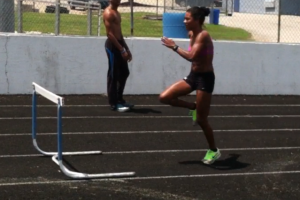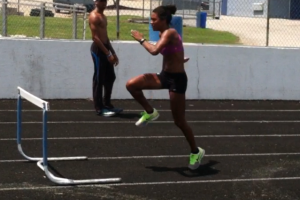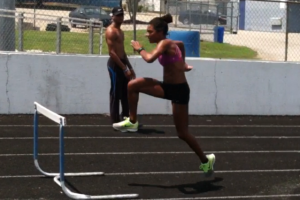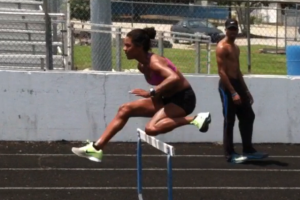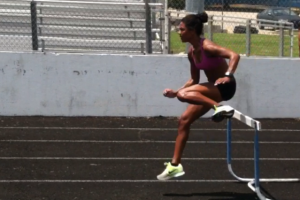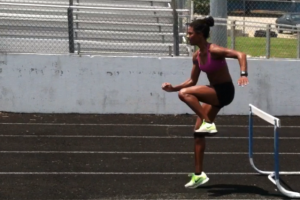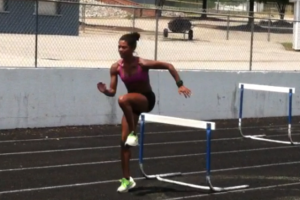Learning to Cycle
Last week I had an athlete visit from out of town for some one-on-one sessions for a few days. Nadia, a 100 meter hurdler, has struggled with the habit of kicking out her lead leg and having her arms go across her body. So I had her do some drills to address those issues.
Mostly we did quick-step hurdling over five hurdles, with the hurdles spaced 22 feet apart. Below is a sequence, from take-off to touchdown, of one of the reps, at the third hurdle.
[am4show not_have=’g5;’]
[/am4show][am4guest]
[/am4guest][am4show have=’g5;’]
As you can see, the aim is to maintain a continuous, fluid action over the hurdle, from the ground to the ground. We are trying to get rid of any extraneous, effort-ful motions that will interrupt the flow of the action. We are not concerned with being powerful or forceful, as we believe that power and force are the result of fluidity and the minimizing of wasted effort. A technique that cannot be carried through over all ten barriers is an inefficient technique. So, no kicking the lead leg, no swinging the arms across the body, no snapping down the lead leg. Our aim is not to hurdle, but to “run over hurdles.”
Over the years, in working with various hurdlers at various stages of development and experience, I find that the most common mistake that I see is that hurdlers put too much effort into hurdling. I think it’s part of the mental conditioning which says that hard work pays off, that the harder you work the more you’ll get out of it, etc. So, when I teach hurdlers how to eliminate the inefficiencies in their hurdling action, they’re surprised at how “easy” it feels to just step over hurdles, and I can tell that they feel that it “shouldn’t” be that easy in a race. “Yes it should,” I tell them, “because you have to clear ten hurdles in a race. If you’re putting too much effort into getting over them, you’re gonna be having breakdowns late in the race.”
With Nadia, the progress came rapidly because she already arrived with the belief that her old ways weren’t working, that she needed to try something new, as she wasn’t getting any faster, despite the fact that she was getting stronger in the weight room and her flat speed was increasing.
Let’s now take a look at the photos above, one by one.
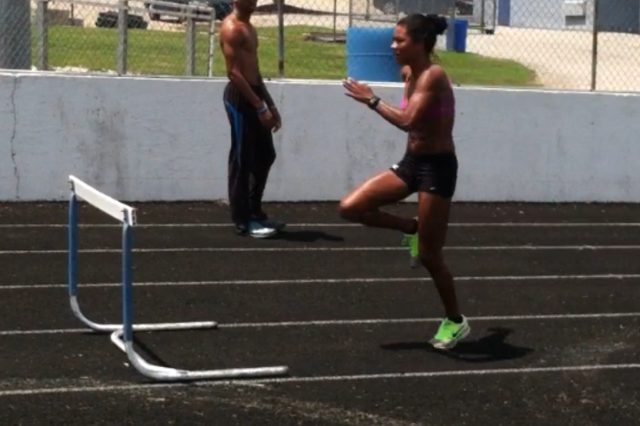
Here, Nadia prepares to take off into the hurdle. Her lead leg knee is rising and driving forward, as is her lead arm. At this point, her lead leg knee is still below the crossbar. The ankle of the lead leg is dorsi-flexed, with the heel rising up toward the upper hamstring, allowing her knee to lead the way. Meanwhile, the leg that will become the trail leg is pushing off the ground as she ever-so-slightly begins to lean forward from the waist.
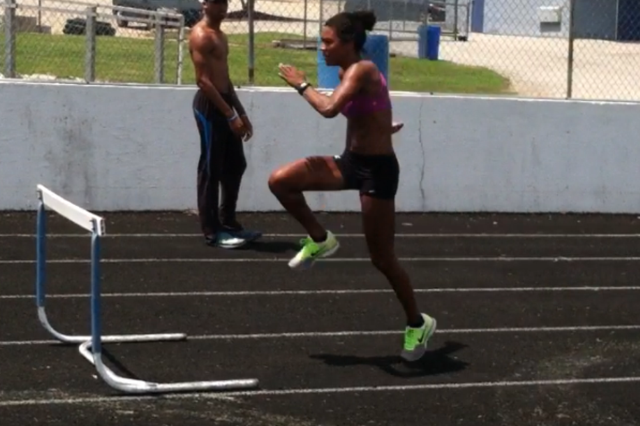
Here, Nadia continues her attack into the hurdle. The knee of the lead leg continues to rise, the lean from the waist becomes more pronounced, and the ankle of the lead leg remains dorsi-flexed. Meanwhile, the lead arm is swinging slightly across her body, which is the biggest problem she came to me with. Here, it’s not too pronounced, but you can see, if you look closely, that the hand of the trail arm is swinging back a little bit too far as a result of the lead arm’s action.
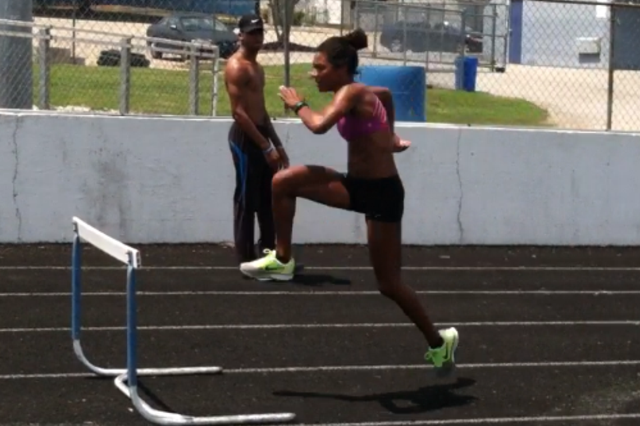
Now Nadia’s trail leg foot is about to leave the ground. Her lead leg knee is now ABOVE the crossbar, which is where we want it to be. This is what it means to “lead with the knee.” Here, the foot is just now beginning to move forward in front of the knee. Meanwhile, she continues to lean a little bit more deeply from the waist while thrusting her hips forward. The lead arm is relatively tight, but continues to move across the body instead of in a strictly up-and-down motion.

On top of the hurdle, Nadia’s lead leg remains bent so that she can properly cycle it, and then cycle the trail leg as well. A lot of hurdlers will flatten out their lead leg at this point in clearance and try their best to “skim” the crossbar along the length of the entire leg. That’s not what we want to do. We want to create a downhill angle like we have here, so that we are coming DOWN on the hurdle, and will therefore be able to come off the hurdle faster than we went into it. You can also see that Nadia’s forward lean is more pronounced, as she pushes her chest down over her lead leg thigh, minimizing her airtime, pushing herself back to the ground. I’ve always said that the lean is not just about hurdle clearance, but even more importantly about creating speed off the hurdle. Meanwhile, Nadia’s trail leg is in excellent position, with the knee facing the front and the toe cocked to avoid contact with the barrier. The lead arm is crossing the body, but if that’s as far across as it goes, then she’ll be okay.
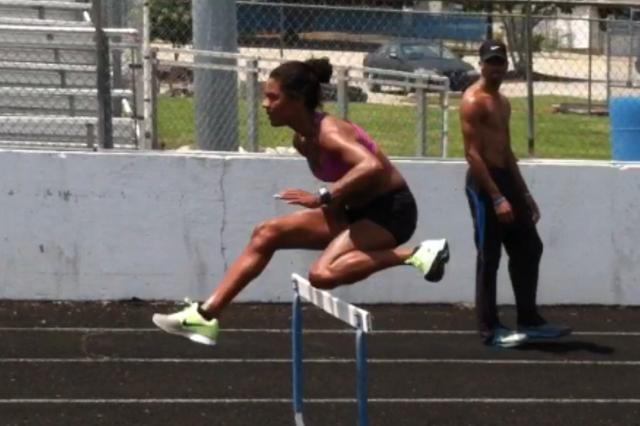
Here, Nadia begins her descent off the hurdle. The lead is in excellent position – slightly bent, ankle dorsi-flexed, with the leg cycling back to the ground in such a manner that it will land under her hip. She maintains her forward lean and thrust from the hips. Doing so is very important because if she were to come out of her lean too soon, she would lose all the momentum she gained by leaning in the first place. Her trail leg knee is pointing down; I’d prefer it to be tilted slightly upward, so that the knee is side by side with the lead leg knee. But the heel of the trail leg remains tucked under the upper hamstring, which is what we want, because it enables the knee of the trail leg to drive to the front as opposed to the leg swinging outward, as it would if the heel got too far away from the hamstring.
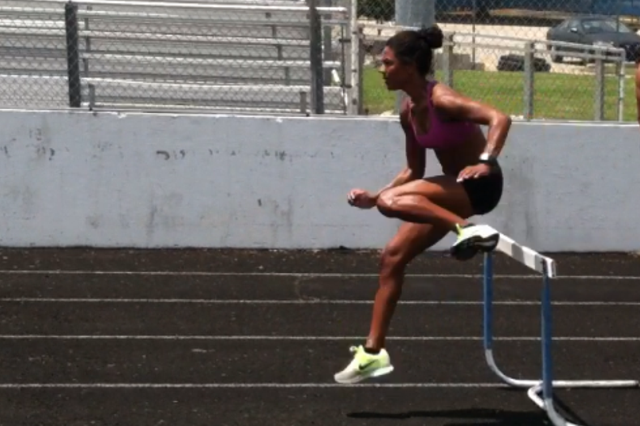
Here, Nadia is just about to touch down, the lead leg continues to extend as the foot readies for impact. A lot of coaches think that a bent lead leg during hurdle clearance means the lead leg doesn’t extend. That’s not the case. As you can see here, the lead leg extends during TOUCHDOWN, on a downward angle, not on top of the hurdle, at a flat angle. Even during touchdown, the lean remains pronounced, ensuring that all momentum continues to move forward. Also take note that the lean is FROM THE WAIST. Never do her eyes look down, never does her chin dip down. Nadia even mentioned that her abs were sorer than they’d ever been, and I told her that was because she was leaning properly and actually using her abs. Meanwhile, the lead arm has moved away from her body just a bit, causing the trail leg to open wider than is preferable. This is a result of the lead arm crossing the body on the other side of the hurdle. Still, the trail leg remains in good position, with the knee facing the front.

Here, at touchdown, Nadia lands on the ball of her foot, and her trail leg knee is facing the front, ready to take the next stride off the hurdle. Lead arm is a little wide, and she’s using it for balance as much as she’s using it to create speed off the hurdle. She is coming out of her lean, but still maintaining a forward angle from the waist up. When you cycle properly over the hurdles, you will not pop up as you land; you will keep the flow going to the next hurdle. Notice too the dorsi-flexion of the trail leg ankle, and the high heel recovery, with the knee staying in front of the foot.
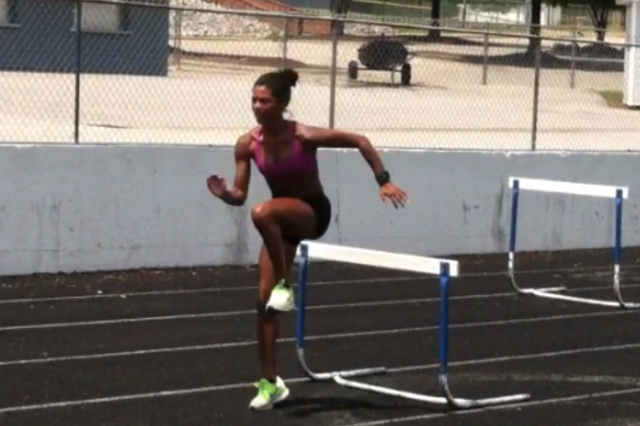
This photo is of another touchdown from a different rep, from a different angle. Here you can see that the arms are in much better position, straight up and down, so that they can power her to the next hurdle instead of helping to balance her off the hurdle. The knee of the trail leg is nice and high, and the lead leg has extended fully. The lean remains pronounced and the hips never stop pushing forward.
The most common queue I gave to Nadia throughout this workout was “run over the hurdle.” The phrase implies that whatever you want to do over the hurdle, you should already be doing those things before you get there, in your strides between. Just keep doing the same things, adding more force upon take-off, a deeper bend from the waist, a higher knee lift. These things don’t change; they’re just more exaggerated, more pronounced. This queue worked very well with her. Instead of thinking about her arms or kicking her lead leg, she just focused on running, and those problems largely fixed themselves.
The one thing she did have to think about was emphasizing the push off the back leg. Being a hurdler who was used to kicking out her lead leg, pushing off the back leg, and relying on that leg to generate speed and power, was foreign to her. But she picked it up very quickly.
Here’s the video of the rep that I based this article upon.
[/am4show]
